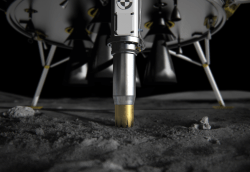The European Space Agency is aiming for the Moon with their Lunar Lander mission, anticipated to arrive on the lunar surface in 2018. Although ESA successfully put a lander on Titan with the Huygens probe in 2005, this will be the first European spacecraft to visit the surface of Earth’s Moon.
 Although Lunar Lander will be an unmanned robotic explorer, the mission will be a forerunner to future human exploration of the Moon as well as Mars. Lunar Lander will use advanced technologies for autonomous landing and will be able to determine the best location for touchdown on its own, utilizing lasers to avoid obstacles on the Moon’s surface.
Although Lunar Lander will be an unmanned robotic explorer, the mission will be a forerunner to future human exploration of the Moon as well as Mars. Lunar Lander will use advanced technologies for autonomous landing and will be able to determine the best location for touchdown on its own, utilizing lasers to avoid obstacles on the Moon’s surface.
With no GPS on the Moon, Lunar Lander will navigate by digitally imaging the surface on the fly. Landing will be accomplished via thrusters, which were successfully tested earlier this year at a test chamber in Germany.
Lunar Lander’s destination will be the Moon’s south pole, where no exploration missions have ever landed. Once on the lunar surface, the Lander will investigate Moon dust using a robotic arm and a suite of onboard diagnostic instruments, sending data and images back to scientists on Earth for further study.
Watch a video of the Lunar Lander mission below, from launch to landing.
Read more about Lunar Lander on the ESA site here.
Images and video: ESA


Wow, I didn’t know about this and it raises so many questions.
– It is developed as a forerunner to Mars landings. So is ExoMars moved back a few years now? (Likely not, because the new precision landing technology will be different from the Viking EDL type.)
– Do we know that sampling Moon dust is any easier than sampling Mars dust? See the Phoenix troubles; that sample mechanism seems pretty naive to me.
– Why the cheesy music and the absence of describing science results? “Lunar Lander’s primary goal is to demonstrate the advanced technologies needed to land precisely and safely.” Granted, but they don’t describe the soil analysis much even at the site.
“Recent orbiting missions have shown that the poles may contain water and it is believed that solar wind particles are trapped there. The water and volatile chemicals hold information on the history and chemistry of the inner Solar System and could even provide resources for future exploration.
Measurements made by Lunar Lander on the surface will confirm measurements made from orbit.
The complex interaction of radiation, illumination, plasma and dust found at the poles will allow Lunar Lander to work as a laboratory for dust plasma physics, providing insight into fundamental processes on all airless bodies such as the Moon, Mercury and asteroids. Understanding the dusty environment and its effects is important for future exploration missions.”
That said, a sampling of Aitken basin ejecta from deep within the young Moon is exciting! The lander will toil with the soil and the dust plasma environment changes for three months, so presumably they can do some thorough analysis whatever it may be. And I am personally pleased that the strong planetary physics tradition of ESA member states is continued with the plasma studies.
Actually, it won’t be the first European spacecraft to visit the Moon; that was the SMART-1 lunar orbiter, in 2003-2006. This will be the first to land on the Moon.
True – to visit the lunar surface. Semantics win; edited to fix.
I don’t want a lander, I want a big mean rover with a live web cam that can be controlled from my seat in turns.
There’s always the Lunar X Prize…